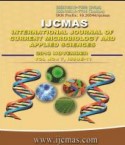


 National Academy of Agricultural Sciences (NAAS)
National Academy of Agricultural Sciences (NAAS)

|
PRINT ISSN : 2319-7692
Online ISSN : 2319-7706 Issues : 12 per year Publisher : Excellent Publishers Email : editorijcmas@gmail.com / submit@ijcmas.com Editor-in-chief: Dr.M.Prakash Index Copernicus ICV 2018: 95.39 NAAS RATING 2020: 5.38 |
The present experiment was carried out to assess the nature and magnitude of genetic variability and divergence among 200 finger millet accessions including four check varieties viz., PRM-1, PRM-2, VL-352 and GPU-28 and also to identify diverse parents for use in further breeding programmes. The seeds of each line were sown in augmented design and each line was represented by one row of 3 meters length and spaced 22.5 cm apart. Variability study indicated moderate phenotypic and genotypic coefficient of variation accompanied by high heritability and moderate genetic advance as per cent of mean for all the traits except number of productive tillers per plant. Mahalanobis D2 statistics grouped all the 200 accessions of finger millet into fifteen clusters. The accessions in cluster VI and XV exhibited higher degree of genetic diversity. The accessions in cluster X were found suitable for days to 50 per cent flowering, number of fingers per plant, plant height, days to maturity, seed yield and 1000-seed weight. Days to 50 per cent flowering and plant height contributed maximum with contribution rate of 48.33 % and 21.79 % respectively towards the genetic divergence. The accession IC-476030 was identified as early maturing with higher seed yield per plant. Therefore, the identified accession can be used in the crossing programme for developing an ideal high yielding variety that can perform better under low temperature conditions at mid and high hills of Uttarakhand.
 |
 |
 |
 |
 |